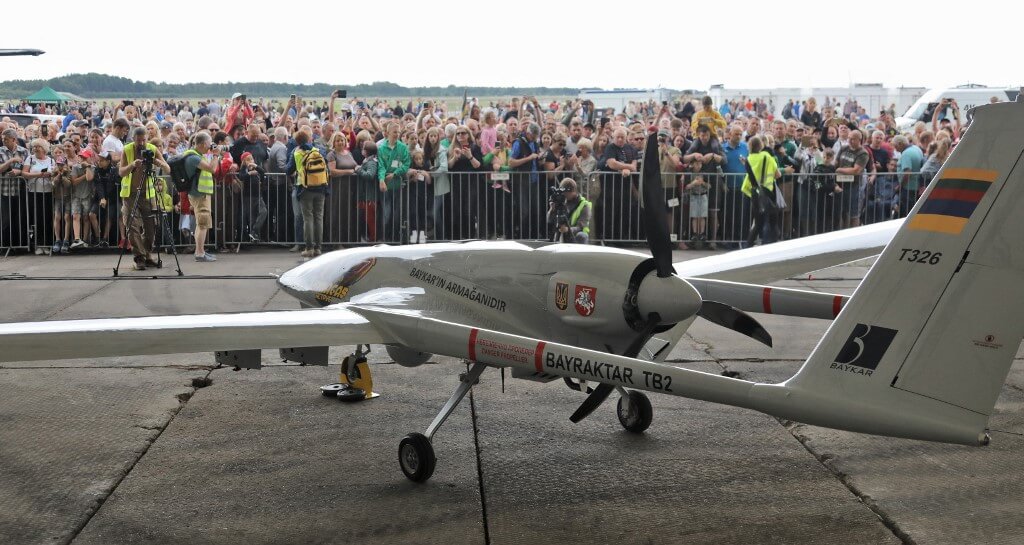Fatih Yurtsever*
In the last decade Turkey has made tremendous strides in developing indigenous unmanned combat aerial vehicles (UCAVs) and smart munitions. The Bayraktar TB2 UCAV, produced by Turkish drone manufacturer Baykar, is exported to 28 countries. With angled wings and a propeller in the rear, the Bayraktar TB2 is flat and can be transported in a flatbed truck. It carries laser-guided bombs, which is much cheaper than similarly equipped American or Israeli drones.
The TB2s have been deployed and used in northern Syria, Libya and Nagorno-Karabakh, which brought the tactic of the precision airstrike to the developing world and reversed the course of several wars. Some military experts close to the government of President Recep Tayyip Erdoğan claim the TB2s are game-changing weapons that radically alter the concept of operations. But are TB UCAVs effective enough to affect the outcome of the war and really a game-changer? What advantages do TB2s give Ukraine over the Russians in the ongoing conflict?
As part of a military modernization program, the Ukrainian Armed Forces acquired 12 UCAVs from Turkey in 2019 and five in 2020. Ukrainian Defense Minister Oleksi Rezkinov said in June 2022 that Kyiv had received 50 drones from Baykar since February 2022.
On April 9, 2021, during the Russian military buildup near Ukraine’s borders, the TB2s conducted air patrols to provide reconnaissance over the Donbas region. This was the TB2’s first mission for Ukraine in an active conflict zone. In October 2021 the TB2 was used in combat missions for the first time in Ukraine. This involved targeting a Russian separatist artillery position, destroying a D-30 howitzer and stopping the bombardment of Ukrainian forces near Hranitne.
On Feb. 24, 2022 Russia launched a direct military operation to invade Ukraine, triggering a total war between the two countries. The success of the drones was widely covered in the early stages of the conflict. In the first months of the war TB2s had been effective against Russian armored and logistics columns. They provided the Ukrainians with the necessary air power to repel the initial Russian assault and slow Russian advances in the Donbas.
According to Oryx, a blog that uses open-source reports to track the destruction of military equipment, these drones are credited with destroying six armored fighting vehicles, five towed artillery, one multi-rocket launcher, two anti-aircraft guns, 10 helicopters, six naval ships, three command posts, one communications station, two logistics trains and numerous resupply trucks. Ukrainian military officer Valery Zaluzhny said two TB2s neutralized $26.5 million in Russian military assets in just three days.
Especially since Ukrainian forces struck the Russian Black Sea Fleet’s flagship, the Moskva cruiser, Russia has lost air control over the Black Sea. As a result, TB2s have neutralized many Russian patrol boats that had no air defense capabilities.
In the early stages of the war, media coverage of the TB2’s success was considerable. Numerous videos showing Ukrainian drones destroying Russian tanks or artillery installations were shared on social networks such as Facebook and Twitter. However, by late June, Ukraine had lost many TB2s due to the advanced Russian air defense and EW systems, evident by the scores of photos and videos published by pro-Russian and Russian government accounts. Information about the TB2’s latest operations has been unavailable since mid-August 2022. According to Samuel Bendett from the Center for Naval Analysis, Russia’s electronic warfare and air defense systems are better organized and equipped compared to the early months of the war. He said Russian forces are using early warning radars to locate drones and that electronic warfare weapons are being used to jam and interfere with their transmission.
As developments during the war clearly demonstrated, once Russia effectively deployed electronic warfare systems and layered air defense systems, the TB2 began to lose its effectiveness in the theater of operations.
According to The EurAsian Times, on Oct. 13, 2022 Russian cyber pranksters Vovan and Lexus posed as US officials and recorded senior Ukrainian official Serhiy Pashinsky criticizing the TB-2 in an online interview. Pashinsky is the people’s deputy of Ukraine and chairman of the Committee of National Security and Defense Council of Ukraine. Pashinsky thought he was talking to former US ambassador to Russia Michael McFaul. He said, “There is more PR and corruption in Bayraktar than combat use.”
“I was personally against it because they are extremely vulnerable to air defense systems. They were all shot down within a week. (The drone) is not a self-sufficient weapon” (it cannot work by itself as it) “gets shot down by air defense systems in a flash and has no combat effectiveness at all,” he said.
Since the Turkish defense industry and domestically produced weapons and systems have become one of the biggest propaganda tools for the Erdoğan administration, it is not possible to make an objective analysis in Turkey on whether TB2s are effective in Ukraine. However, it can be said that in the early stages of the Russo-Ukrainian war, TB2s were partially successful due to the absence of Russian integrated air defenses, similar to Syria, Libya and Nagorno-Karabakh. Under these circumstances, it is difficult to argue that TB2 UCAVs would have a game-changing effect in a conventional war.
* Fatih Yurtsever is a former naval officer in the Turkish Armed Forces. He is using a pseudonym out of security concerns.
